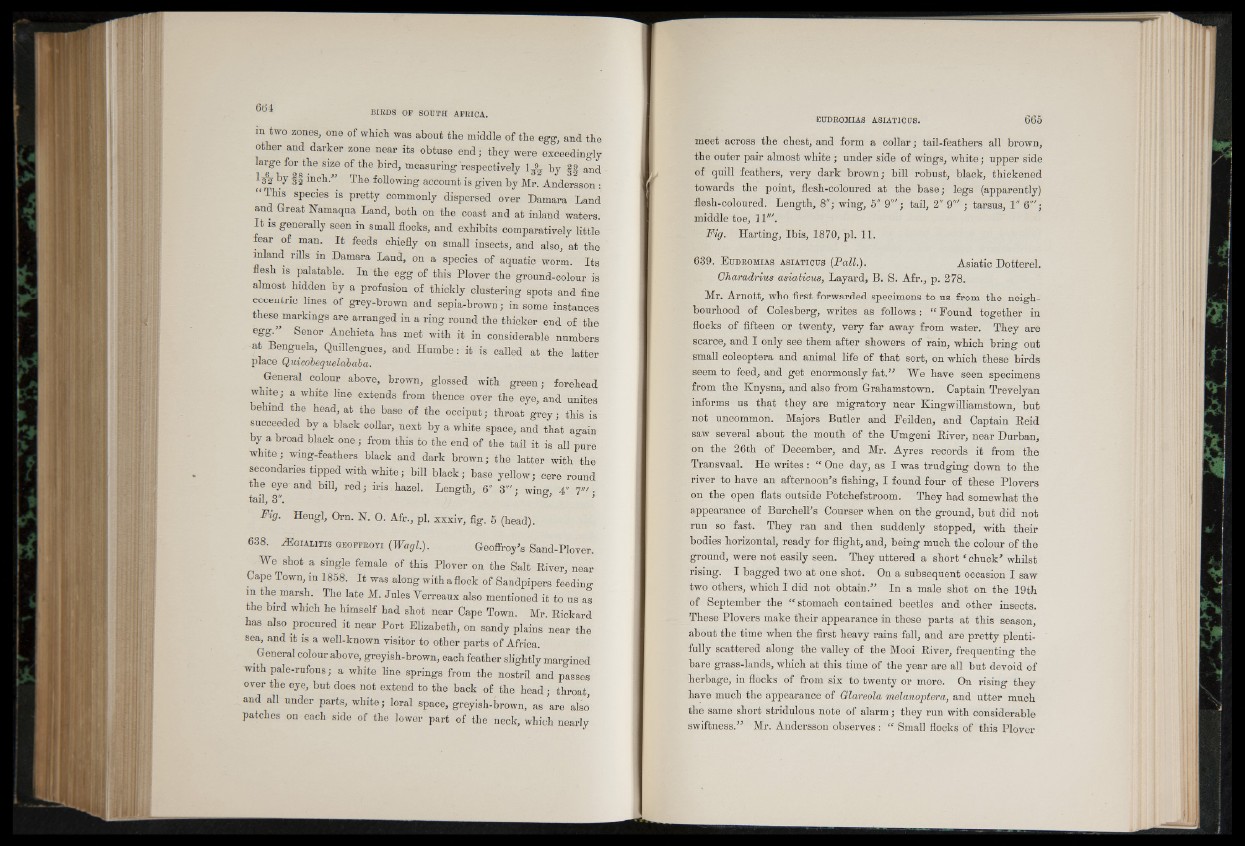
m two zones, one of which was about the middle of the egg, and the
other and darker zone near its obtuse end; they were exceedingly
large for the size of the bird, measuring 'respectively 1^2 by f § and
fcy f | inch.” The following account is given by Mr. Andersson :
This species is pretty commonly dispersed over Damara Land
and Great Namaqua Land, both on the coast and at inland waters.
It is generally seen in small flocks, and exhibits comparatively little
fear of man. It feeds chiefly on small insects, and also, at the
inland rills in Damara Land, on a species of aquatic worm. Its
flesh is palatable. In the egg of this Plover the ground-colour is
almost hidden by a profusion of thickly clustering spots and fine
eccentric lines of grey-brown and sepia-brown; in some instances
these^markmgs are arranged in a ring round the thicker end of the
egg.” Senor Anchieta has met with it in considerable numbers
at Benguela, Quillengues, and Humbe: it is called at the latter
place Quicobequelababa.
General colour above, brown, glossed with green; forehead
white; a white line extends from thence over the eye, and unites
behind the head, at the base of the occiput; throat grey; this is
succeeded by a black collar, next by a white space, and that again
by a broad black one; from this to the end of the tail it is all pure
white; wmg-feathers black and dark brown; the latter with the
secondaries tipped with white; bill black; base yellow; cere round
the eye- and bill, red; iris hazel. Length, 6" 3'" • wine- 4" 7'" ■
tail, 3".
Fig. Heugl, Orn. 1ST. 0. Afr., pi. xxxiv, fig. 5 (head).
638. HUg ia l it is g eoffroyi (Wagl). Geoffrey's Sand-Plover.
We shot a single female of this Plover on the Salt River, near
Cape Town, in 1858. It was along with a flock of Sandpipers feeding
m the marsh. The late M. Jules Verreaux also mentioned it to us as
the bird which he himself had shot near Cape Town. Mr. Rickard
has also procured it near Port Elizabeth, on sandy plains near the
sea, and it is a well-known visitor to other parts of Africa.
General colour above, greyish-brown, each feather slightly margined
with pale-rufous; a white line springs from the nostril and passes
over the eye, but does not extend to the back of the head; throat,
and all under parts, white; loral space, greyish-brown, as are also
patches on each side of the lower part of the neck, which nearly
meet across the chest, and form a collar; tail-feathers all brown,
the outer pair almost white; under side of wings, white; upper side
of quill feathers, very dark brown; bill robust, black, thickened
towards the point, flesh-coloured at the base; legs (apparently)
flesh-coloured. Length, 8"; wing, 5" 9"'; tail, 2" 9"'; tarsus, 1" 6'";
middle toe, l l '”.
Fig. Harting, Ibis, 1870, pi. 11.
639. E udromias a sia t icu s (Pall.). Asiatic Dotterel.
Gharadrius asiaticus, Layard, B. S. Afr., p. 278.
Mr. Arnott, who first forwarded specimens to us from the neighbourhood
of Colesberg, writes as follows : “ Found together in
flocks of fifteen or twenty, very far away from water. They are
scarce, and I only see them after showers of rain, which bring out
small coleóptera and animal life of that sort, on which these birds
seem to feed, and get enormously fat.” We have seen specimens
from the Knysna, and also from Grahamstown. Captain Trevelyan
informs us that they are migratory near Kingwilliamstown, but
not uncommon. Majors Butler and Feilden, and Captain Reid
saw several about the mouth of the TJmgeni River, near Durban,
on the 26th of December, and Mr. Ayres records it from the
Transvaal. He writes : “ One day, as I was trudging down to the
river to have an afternoon’s fishing, I found four of these Plovers
on the open flats outside Potchefstroom. They had somewhat the
appearance of Burchell’s Courser when on the ground, but did not
run so fast. They ran and then suddenly stopped, with their
bodies horizontal, ready for flight, and, being much the colour of the
ground, were not easily seen. They uttered a sh o rtf chuck’ whilst
rising. I bagged two at one shot. On a subsequent occasion I saw
two others, which I did not obtain.” In a male shot on the 19th
of September the “ stomach contained beetles and other insects.
These Plovers make their appearance in these parts at this season,
about the time when the first heavy rains fall, and are pretty plentifully
scattered along the valley of the Mooi River, frequenting the
bare grass-lands, which at this time of the year are all but devoid of
herbage, in flocks of from six to twenty or more. On rising they
have much the appearance of Glareola melanoptera, and utter much
the same short stridulous note of alarm; they run with considerable
swiftness.” Mr. Andersson observes : “ Small flocks of this Plover